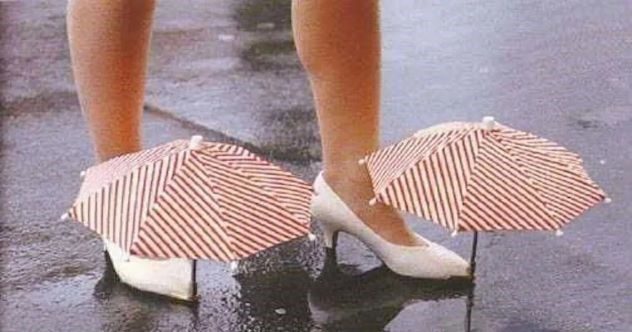Throughout history, human ingenuity has given birth to inventions that have transformed lives, shaped societies, and propelled civilizations forward. From the wheel to the internet, these innovations have marked significant milestones in human development. However, not every creation has been a hit.
In the vast ocean of ingenuity, there are some inventions that, despite their creators’ best intentions, have sunk without a trace due to their impracticality, inefficiency, or sheer absurdity. This list is a light-hearted exploration of the 10 most useless inventions in human history. It highlights those peculiar ideas that make us wonder, “What were they thinking?”
From gadgets that solve non-existent problems to devices that complicate rather than simplify, these inventions offer a humorous reminder that failure is just a stepping stone to success. So let’s dive into the quirky side of innovation and discover the inventions that history, quite rightly, forgot.
Related: Ten Absurd Inventions That Are More Useful Than You Might Think
10 The Pet Rock
In the mid-1970s, the Pet Rock became a cultural phenomenon, arguably one of the most useless yet wildly successful inventions in consumer history. Its creator, Gary Dahl, marketed these ordinary rocks as if they were live pets, complete with a carrying case and a comprehensive owner’s manual on their care and training. Despite offering no interaction, no growth potential, and no real purpose beyond sitting inert, the Pet Rock captured the imagination of millions, turning into a short-lived but intense fad.
This invention perfectly illustrates how clever marketing can create demand for a product that is, at its core, completely unnecessary and functionally useless. The Pet Rock phenomenon is a humorous testament to the quirks of consumer culture and the power of novelty. It reminds us that sometimes the most useless inventions can become memorable parts of history, not for their practicality but for their ability to tap into the zeitgeist of a particular moment in time.[1]
9 The USB Pet Rock
Decades after the original Pet Rock took the 1970s by storm, a modern twist on this classic useless invention emerged: the USB Pet Rock. This version, a rock with a USB cable attached that you could plug into your computer, offered no digital functionality whatsoever. It didn’t store data, improve computer performance, or interact with software in any way. Essentially, it was just a rock with a cable that took up a valuable USB port.
The USB Pet Rock serves as a playful nod to its predecessor, capitalizing on nostalgia and the absurdity of connecting a piece of nature to the height of modern technology. While it could be seen as a statement on simplicity in an increasingly complex digital world, it remains an utterly useless invention, highlighting how some ideas are recycled for new generations—sometimes more for amusement than utility.[2]
8 Diet Water
In 2004, the concept of “Diet Water” was brought to life by Sapporo, a company better known for its beer, with the introduction of its “Diet Water” in Japan. This product aimed to offer all the benefits of regular water but with added weight loss properties, despite water naturally having zero calories. Sapporo’s Diet Water was infused with “peptides” that were claimed to help with weight reduction, targeting consumers eager to shed pounds without effort.
The invention of Sapporo Diet Water underscores the extent to which the diet industry can stretch the bounds of logic to appeal to weight-conscious consumers. It capitalizes on the pervasive desire for quick-fix health solutions, creating a market for a product that essentially repackages one of life’s free necessities as a commercial, health-enhancing commodity.
Despite its ambitious claims, Diet Water is often cited as an example of an utterly unnecessary product, highlighting the absurdity of some health and wellness trends. This episode in marketing history serves as a cautionary tale about the importance of scrutinizing the claims of diet products, reminding us that not all innovations offer meaningful benefits beyond their novelty.[3]
7 The DVD Rewinder
In a blend of technological misunderstanding and pure novelty, the DVD Rewinder emerged as a real product that played upon the nostalgia of VHS tapes. Unlike VHS tapes, which need rewinding to maintain their lifespan and usability, DVDs do not require such a process due to their digital nature. The DVD Rewinder, therefore, stands as a monument to technological redundancy, offering a solution to a problem that does not exist with modern digital media.
Marketed with a tongue-in-cheek approach, the device was intended more as a gag gift than a serious product. It humorously catered to those either nostalgic for the ritual of rewinding tapes or unaware of the basic functioning of DVDs. Despite its clear lack of utility, the DVD Rewinder is a testament to the quirky side of consumer electronics, where humor and nostalgia can create a market for an invention that, by all logical standards, serves no practical purpose.[4]
6 The Banana Slicer
The Banana Slicer is a kitchen gadget designed to slice a whole banana into even pieces with one quick motion. While it might seem like a convenient tool for preparing fruit salads or toppings, its necessity is questionable. Bananas, with their soft texture, are easily sliced with a regular knife, and the banana slicer’s one-size-fits-all design doesn’t accommodate varying banana sizes and curvatures. This results in an invention that, while mildly useful for some, is largely redundant for the majority of kitchen tasks involving bananas.
This product epitomizes the trend of creating highly specific kitchen tools that solve problems of minor inconvenience at best. The Banana Slicer’s existence in the market reflects a broader phenomenon where the saturation of kitchen gadgets leads to the production of items with incredibly niche uses. Despite its intentions to simplify a mundane task, the slicer ultimately serves as a humorous example of when the pursuit of convenience in kitchen gadgetry goes a step too far, offering a solution to a problem scarcely recognized as such.[5]
5 The Goldfish Walker

In an attempt to blend pet care with the absurd, the Goldfish Walker stands out as one of the more whimsical and unnecessary inventions in recent history. Designed to allow goldfish owners to take their aquatic pets for a “walk,” this invention consists of a water-filled, transparent tank on wheels. The idea behind the Goldfish Walker is to provide pet fish with a change of scenery and the experience of being outdoors, despite the obvious fact that fish are likely unaware of their surroundings in such a manner.
The invention highlights human projection of needs onto pets that don’t share the same requirements or perceptions as terrestrial animals like dogs or cats. While the Goldfish Walker might have been created with the best intentions to enhance the lives of pet fish, it ultimately serves no practical purpose for the pets it’s designed for. It’s a testament to the lengths to which pet owners will go to include their non-traditional pets in everyday activities, even when those activities offer no real benefit to the animals involved. This invention amusingly underscores the human desire for connection with pets, regardless of the practicality or necessity of the means.[6]
4 The USB Humping Dog
The USB Humping Dog is a novelty gadget that, upon being plugged into a USB port, simulates a dog humping. This invention offers no storage capacity or practical function as a USB device. Its sole purpose is to entertain or amuse by performing a repetitive motion. Emerging in the mid-2000s, this gadget became a popular gag gift, embodying the era’s fascination with quirky and humorous tech accessories that serve no real utility beyond a laugh.
This product exemplifies the peak of novelty in the tech world, where the line between technology and toys blurs. While amusing, the USB Humping Dog also highlights a curious aspect of consumer culture that delights in uselessness as a form of entertainment. It’s a commentary on the proliferation of USB gadgets at the time, many of which offered dubious utility. Despite its lack of functionality, the USB Humping Dog remains a memorable piece of tech memorabilia, reminding us of the lighter side of technological innovation.[7]
3 The Walking Sleeping Bag
The Walking Sleeping Bag, designed to allow wearers the mobility to walk around while remaining enveloped in the warmth of their bedding, epitomizes the clash between convenience and practicality. This invention adds legs to the traditional sleeping bag design, ostensibly to combine the comfort of staying warm with the functionality of being able to move about. While the idea might seem appealing for camping trips or cold winter nights at home, its practical usage is questionable.
In practice, the mobility offered by the Walking Sleeping Bag is limited, and the product often ends up being more cumbersome than useful. Users find it awkward to walk in, and it fails to replace the need for proper outdoor clothing. Moreover, its design compromises the very essence of a sleeping bag’s purpose—to provide a snug, insulating layer against the elements—by introducing the potential for drafts and reduced warmth. This invention serves as a humorous reminder that not all innovations make life easier, and sometimes, sticking to the basics is best.[8]
2 The Necktie Flask
The Necktie Flask, an attempt to blend fashion with hidden functionality, caters to those wanting to discreetly carry a beverage of choice. Designed like a regular necktie but with a hidden compartment and a small nozzle near the tie’s end, it allows the wearer to sip liquids on the go. While it might sound like a clever accessory for parties or social events where beverages are expensive or not to one’s liking, its practicality and appropriateness are questionable.
This invention raises eyebrows for promoting the sneaky consumption of alcohol in settings where it might be frowned upon or outright banned. The limited capacity of the flask, coupled with the potential for spills and stains, further diminishes its utility. Moreover, the Necktie Flask rarely goes unnoticed, which can lead to awkward social situations. While innovative in its approach to concealment, this product exemplifies how some inventions, despite their creative intent, fall short in balancing novelty with genuine usefulness and social etiquette.[9]
1 The Shoe Umbrella
The Shoe Umbrella is an invention designed to protect footwear from rain, splashes, and general wet conditions. Mounted on a small frame that attaches to shoes, these mini umbrellas aim to keep the wearer’s feet dry and their shoes unblemished by water or mud. While the concept might appeal to those keen on preserving the appearance of their footwear, the practicality and effectiveness of Shoe Umbrellas are often called into question.
Critics argue that Shoe Umbrellas fail to provide comprehensive protection against rain, especially in windy conditions or when rain comes from the side. Additionally, their small size and the inconvenience of attaching them to shoes make them less effective than simply wearing waterproof footwear or carrying a regular umbrella. The invention is also seen as a fashion faux pas, drawing more attention to the wearer’s feet in a manner that’s often not stylish.
Shoe Umbrellas highlight a trend in inventing products that address very specific concerns, sometimes at the cost of practicality and aesthetics. While they attempt to solve the problem of wet and dirty shoes, they arguably create more hassle than simply preparing for inclement weather with more conventional methods. This invention serves as a quirky example of how not every problem requires a high-tech or novel solution, especially when traditional alternatives exist.[10]
